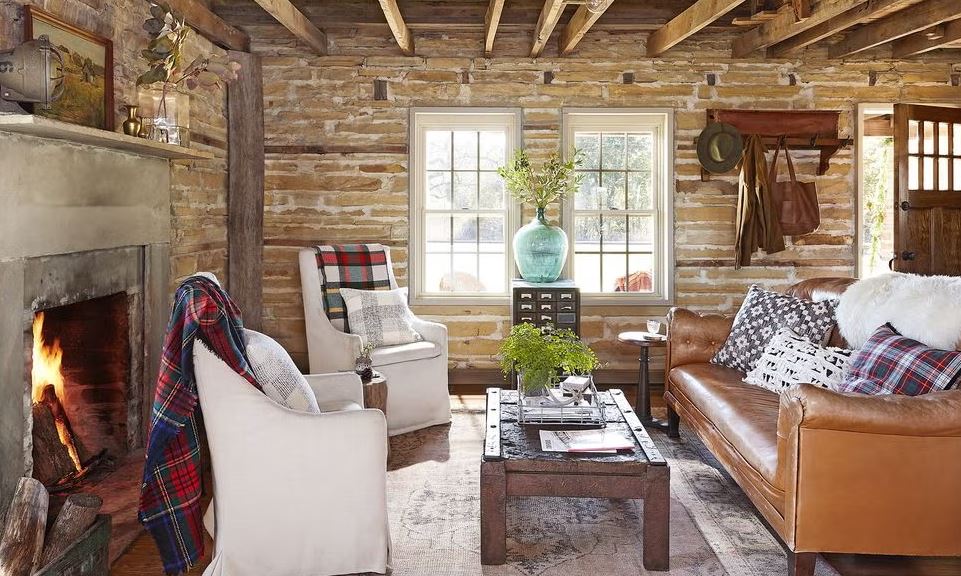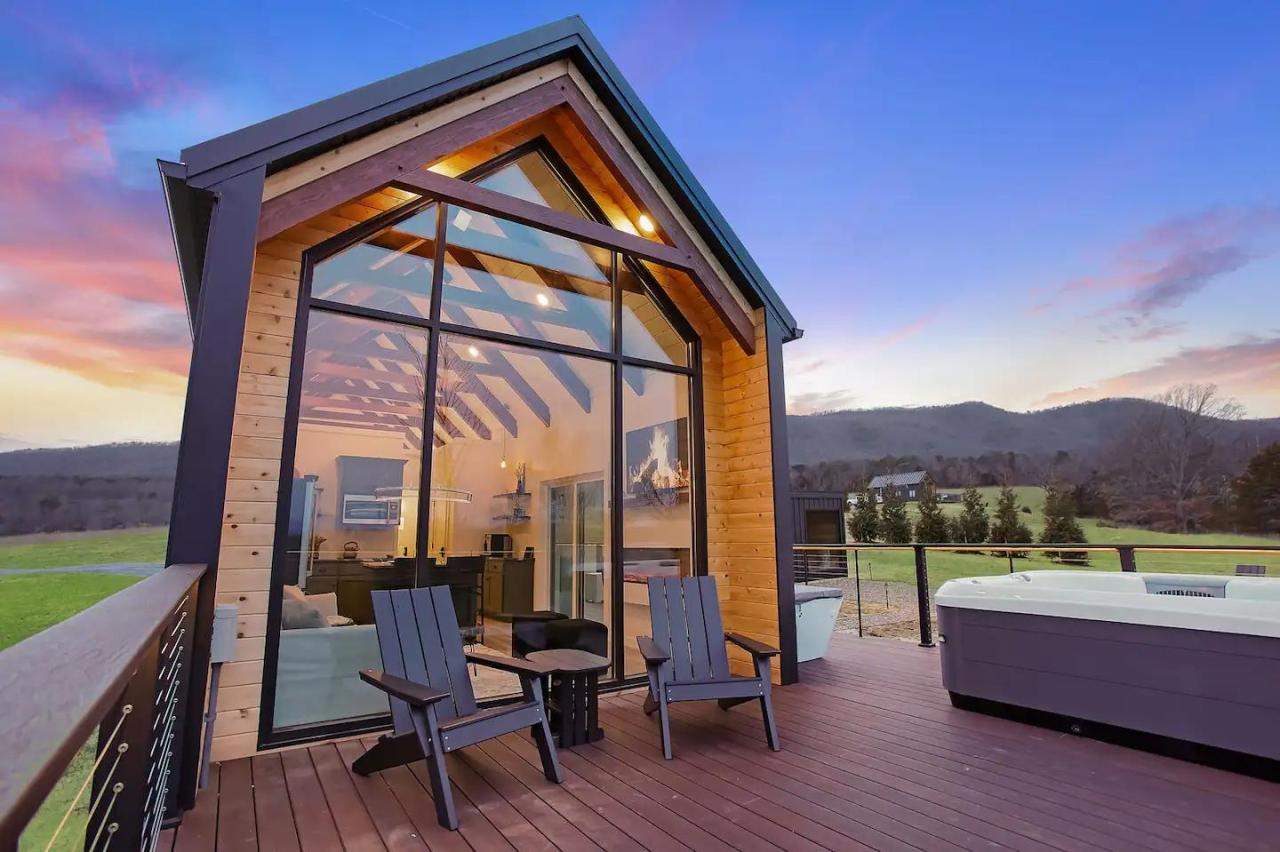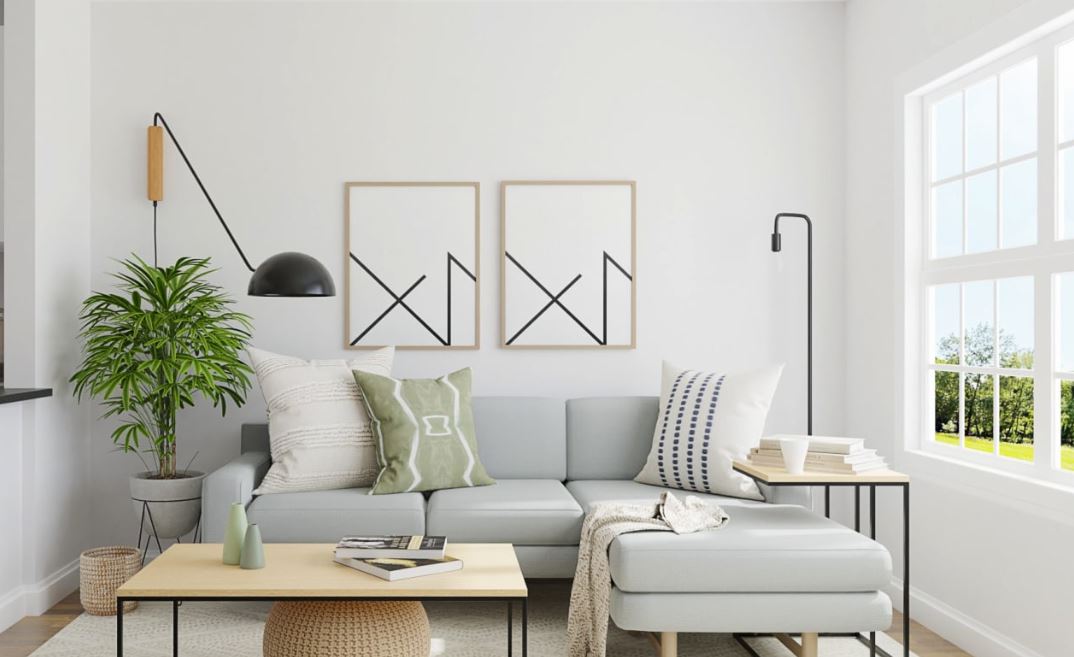Modern elegant dining room design is all about creating a space that’s both stylish and inviting. It blends sleek lines with warm touches, focusing on functionality and visual appeal. This guide explores the key elements of crafting a stunning modern elegant dining area, from furniture selection and lighting choices to space planning and material selection. Get ready to transform your dining experience into a sophisticated and memorable event.
We’ll delve into the aesthetics of modern elegance, exploring color palettes, lighting strategies, and the importance of scale and proportion in furniture placement. We’ll also cover different dining table styles, chair designs, and accessories to create a cohesive and sophisticated atmosphere. Prepare to be inspired!
Defining Modern Elegance
Modern elegance in a dining room transcends mere aesthetics; it’s a thoughtful blend of sophisticated design elements that create a welcoming and refined atmosphere. It’s about achieving a harmonious balance between contemporary style and timeless appeal, leaving a lasting impression on guests. This sophisticated approach avoids the pitfalls of overly fussy or stark minimalism.
Modern elegance is distinguished by clean lines, neutral color palettes, and carefully chosen, high-quality materials. It’s about highlighting functionality and visual appeal simultaneously. The style is less about trends and more about enduring principles of design.
Aesthetic Qualities of Modern Elegance
Modern elegance in a dining room prioritizes a calm and sophisticated ambiance. This is achieved through a careful selection of materials, textures, and colors that create a sense of serenity and refinement. Key aesthetic qualities include sleek, uncluttered surfaces, a focus on natural light, and a sense of spaciousness. Furniture often features clean lines and a smooth, polished finish.
Key Elements Distinguishing Modern Elegance
Several elements set modern elegance apart from other styles. Modern elegance emphasizes a harmonious balance between form and function. This is reflected in the carefully chosen materials, furniture shapes, and lighting choices. The style leans towards a sense of spaciousness, created through careful arrangement and well-considered proportions. Emphasis is placed on high-quality craftsmanship, ensuring the longevity and enduring appeal of the design. Contrast is often used to create visual interest without overwhelming the space.
Comparison with Other Styles
Modern elegance differs from contemporary style in its subtle approach. Contemporary design can be more dramatic and experimental, whereas modern elegance emphasizes a more refined and restrained aesthetic. Minimalism, often associated with a lack of ornamentation, contrasts with the thoughtful inclusion of carefully selected details in modern elegance. Traditional styles, with their intricate patterns and ornate details, stand in stark contrast to the clean lines and neutral color palettes of modern elegance.
Color Palettes and Their Impact
Neutral color palettes are a hallmark of modern elegance. These palettes often include variations of greys, creams, beiges, and blacks. Warm neutrals like beige and cream can create a cozy atmosphere, while cool neutrals like grey and black add a sense of sophistication. Accent colors, such as deep blues, emerald greens, or rich terracotta, can be strategically incorporated to add depth and visual interest without overwhelming the space.
Role of Lighting in Creating Atmosphere
Lighting plays a crucial role in establishing the desired ambiance in a modern elegant dining room. Natural light is often maximized through large windows and strategically placed mirrors. Ambient lighting, such as recessed lighting or chandeliers with clean lines, provides overall illumination. Task lighting, such as pendant lights over the dining table, ensures focused illumination for meals. The careful combination of these lighting elements creates a sophisticated and inviting atmosphere.
Mood Board: Color Palettes and Lighting Options
This mood board illustrates several color palettes and lighting options for a modern elegant dining room.
- Palette 1: A sophisticated palette featuring various shades of gray, accented by deep navy blue for the dining chairs and table runners. The lighting would consist of ambient recessed lighting, complemented by a sleek, modern chandelier. The overall effect is sophisticated and serene.
- Palette 2: A warm palette featuring a combination of creamy white, warm beige, and soft gray. The lighting would include soft, diffused pendant lights over the dining table, along with recessed lighting. This palette creates a cozy and welcoming atmosphere.
- Palette 3: A cool palette featuring deep charcoal gray, sleek white accents, and touches of metallic gold. The lighting would involve a combination of ambient lighting, task lighting above the table, and accent lighting to highlight architectural features.
The above palettes represent a variety of moods that can be created within a modern elegant dining room, highlighting the importance of thoughtful color and lighting choices. Each palette can be adapted to suit individual tastes and preferences.
Furniture Selection: Modern Elegant Dining Room
Choosing the right furniture is crucial for creating a modern elegant dining room. The furniture should not only be aesthetically pleasing but also functional and comfortable for everyday use. Consider the space’s dimensions, the overall design aesthetic, and the number of people you frequently dine with when making your selections. Careful consideration of materials, shapes, and proportions will result in a harmonious and inviting dining experience.
Selecting furniture that embodies both style and functionality is key to achieving a modern elegant dining room. The pieces should complement the overall design scheme, ensuring that the room feels cohesive and sophisticated. Careful attention to detail, from the wood grain to the fabric texture, contributes to the overall ambiance.
Dining Table Selection
Dining tables are the focal point of any dining room. Choosing the right shape and size is essential for both aesthetics and practicality. Consider the space available and the number of people you anticipate dining with regularly. Rectangular tables are versatile and suitable for larger gatherings, while round tables foster a more intimate atmosphere. Square tables offer a modern, structured feel. The material choice for the table top, such as wood or glass, further influences the overall design.
Dining Table Shapes and Sizes
A rectangular table is often the most practical choice for larger families or those who frequently entertain. Its extended length allows for a greater seating capacity. Round tables promote a more intimate and conversational setting. Their circular design encourages interaction among diners. Square tables offer a modern, structured feel, suitable for smaller dining areas or those who prefer a more minimalist aesthetic. The size of the table should be proportional to the room’s dimensions to avoid overwhelming or underutilizing the space.
Materials and Finishes
The choice of materials directly impacts the overall aesthetic and durability of the dining room furniture. Solid wood, known for its natural beauty and longevity, remains a popular choice. Different wood types like oak, walnut, or maple offer varying shades and textures. Glass tops provide a sleek, contemporary look, while metal frames can add a touch of industrial sophistication. Fabric upholstery, such as leather or linen, adds warmth and comfort to dining chairs.
Dining Chairs
Selecting chairs that complement the table and overall design is essential. Consider the table’s shape and the overall aesthetic of the room. Modern elegant dining chairs often feature clean lines, comfortable seating, and a variety of materials. Armchairs provide additional support and comfort, while side chairs offer a more minimalist feel. Look for chairs with high-quality craftsmanship and durable construction.
Furniture Examples
| Furniture Type | Description | Image (Description) |
|---|---|---|
| Rectangular Dining Table | A large, sturdy table made of solid oak with a natural finish. The table’s rectangular shape allows for ample seating for eight to ten people. | A solid oak table with a rich brown finish, showcasing visible wood grain. The rectangular shape is clear and defined, with straight edges. |
| Round Dining Table | A stylish round dining table with a tempered glass top supported by a sleek metal base. Perfect for smaller dining areas and intimate gatherings. | A round table with a clear glass top. A simple, elegant metal base supports the glass top, creating a clean and contemporary look. |
| Dining Chairs | A set of four dining chairs with upholstered seats and backs in a dark gray linen fabric. The chairs have a simple, modern design with clean lines and comfortable seating. | Four chairs with a simple frame and dark gray fabric upholstery. The chairs are shown in a relaxed arrangement, suggesting comfort and usability. |
Lighting and Accessories
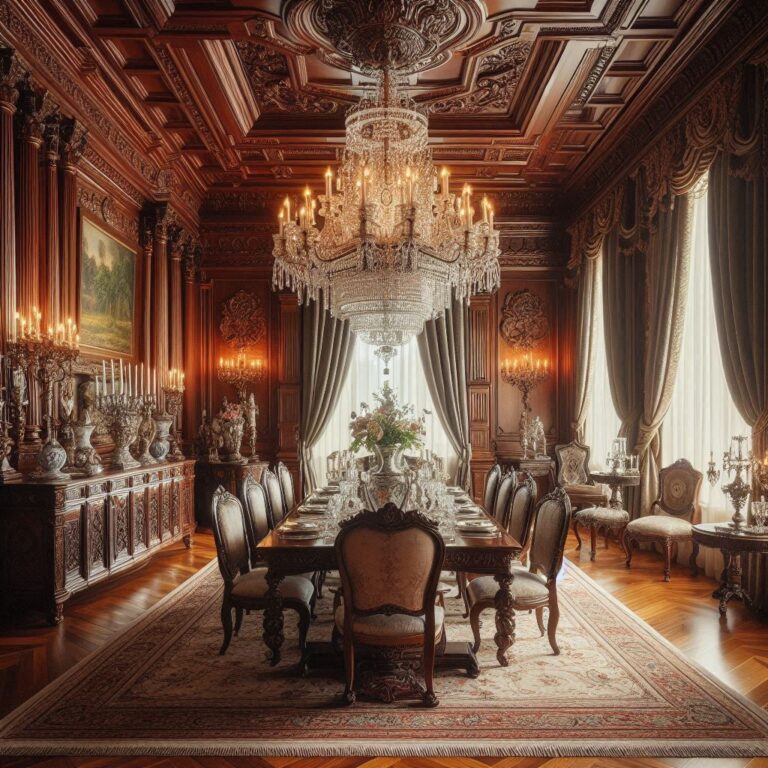
Source: reviewsparrow.com
Lighting plays a crucial role in setting the mood and ambiance of a dining room, especially in a modern elegant space. Well-chosen lighting fixtures can highlight architectural details, create a warm and inviting atmosphere, and enhance the overall aesthetic appeal. The right lighting complements the furniture and accessories, making the space feel more sophisticated and refined.
Proper lighting distribution is essential in a dining room. It’s not just about having light; it’s about having the *right* kind of light in the *right* places. This creates visual interest, guides the eye, and ultimately elevates the dining experience.
Lighting Fixtures and Placement
Effective lighting design involves strategically placing different types of fixtures to illuminate the dining area. A combination of ambient, task, and accent lighting creates a well-rounded and functional space. Ambient lighting provides overall illumination, while task lighting focuses on specific areas, like the dining table, ensuring comfortable visibility during meals. Accent lighting highlights architectural features or artwork, adding depth and visual interest.
- Ambient Lighting: This provides the foundational illumination for the room. Recessed lighting, chandeliers, or large pendant lights can be used. Ensure the ambient lighting is neither too harsh nor too dim, striking a balance between brightness and warmth.
- Task Lighting: This focuses light directly on the dining table for optimal visibility during meals. Table lamps or pendant lights directly above the table can be excellent choices. Consider the height of the lighting fixture to avoid glare and ensure comfortable visibility for all diners.
- Accent Lighting: This highlights specific features or decorative elements. Wall sconces, spotlights, or cove lighting can be used to draw attention to artwork, architectural details, or decorative accessories. The goal is to add depth and visual interest to the room.
Decorative Accessories
Accessories play a significant role in defining the style and personality of a modern elegant dining room. Choosing the right accessories can add a touch of elegance and sophistication to the space.
- Vases and Bowls: Vases and bowls can add a touch of elegance and sophistication to the room. Consider using a variety of sizes and shapes to create visual interest. Fill them with fresh flowers or decorative items for a pop of color and texture.
- Candles and Candleholders: Candles can create a warm and inviting atmosphere. Use candles in different sizes and shapes, with varying colors, to create a sense of visual interest. Choose candleholders that complement the overall design aesthetic.
- Wall Decor: Artwork, mirrors, and other wall decorations can add personality and visual interest to the room. Select pieces that align with the overall color scheme and style of the dining room. A large statement piece can act as a focal point, while smaller pieces can add texture and dimension.
Textiles
Textiles, such as curtains, tablecloths, and cushions, add warmth, texture, and visual interest to a modern elegant dining room. The choice of textiles should complement the overall design aesthetic and color palette.
- Curtains: Curtains can add a touch of elegance and sophistication to the room. Choose fabrics that are both durable and aesthetically pleasing, and select colors and patterns that complement the overall design.
- Tablecloths and Runners: Tablecloths and runners can add a touch of elegance and formality to the dining table. Choose fabrics that are both durable and visually appealing. Consider using linen, silk, or other luxurious materials for a sophisticated look.
- Cushions and Throw Pillows: Cushions and throw pillows add texture and visual interest to the seating area. Select fabrics that complement the overall design aesthetic and color palette.
Artwork and Mirrors
Artwork and mirrors can add a touch of personality and visual interest to a modern elegant dining room. Careful selection of artwork and mirrors can create a focal point and enhance the overall design.
- Artwork: Artwork can add personality and visual interest to a dining room. Choose pieces that complement the overall design aesthetic and color palette. Consider using a combination of different sizes and styles to create a layered effect.
- Mirrors: Mirrors can add a touch of sophistication and visual interest to a dining room. Select mirrors that complement the overall design aesthetic and color palette. Consider using mirrors to reflect light and create a sense of spaciousness.
Lighting Fixtures and Accessories Table
| Fixture/Accessory | Description |
|---|---|
| Chandelier | A decorative light fixture that hangs from the ceiling, often with multiple arms and light bulbs. |
| Pendant Lights | Lights that hang from the ceiling, typically single or grouped, offering focused light. |
| Table Lamp | A lamp designed to sit on a table, offering focused light for a specific area. |
| Wall Sconces | Wall-mounted lights that provide ambient or accent lighting. |
| Vases | Decorative containers, often used to hold flowers or other decorative items. |
| Candles | Small containers of wax that burn, providing a warm and inviting ambiance. |
| Artwork | Decorative pieces, including paintings, sculptures, or photographs, adding personality and visual interest. |
| Mirrors | Reflective surfaces that add a touch of sophistication and spaciousness. |
Space Planning and Layout
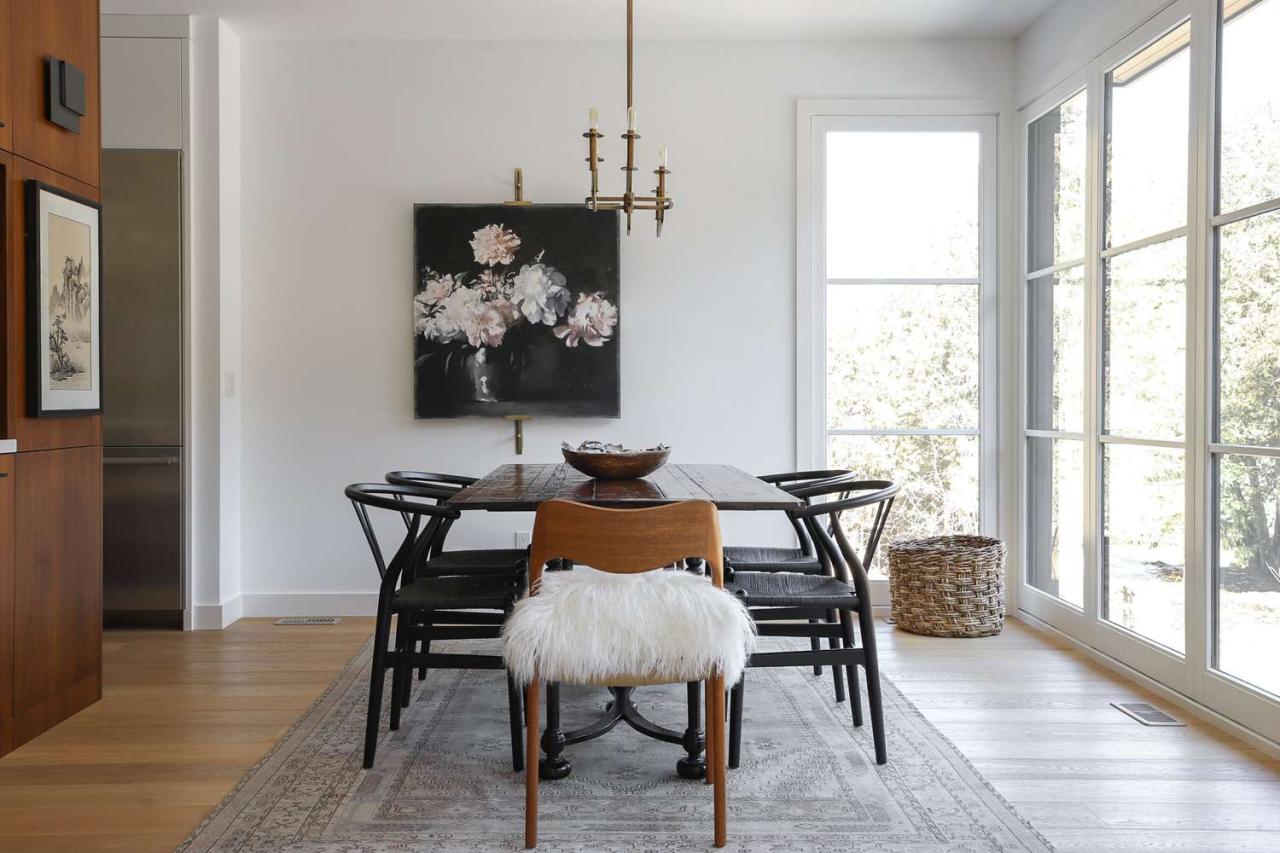
Source: thespruce.com
Creating a functional and visually appealing modern elegant dining room hinges heavily on thoughtful space planning. Effective layout strategies not only maximize the room’s potential but also enhance the overall aesthetic appeal. Careful consideration of natural light, traffic flow, and accessibility plays a crucial role in achieving the desired ambiance.
Proper space planning ensures the dining area seamlessly integrates with the surrounding space, whether it’s an open-plan layout or a more traditional design. This includes strategic furniture placement, lighting considerations, and the selection of appropriate accessories.
Space Planning Strategies
Effective space planning for a modern elegant dining room involves careful consideration of various factors. Understanding the dimensions of the room and the intended use of the space are critical for creating a functional and visually appealing layout. The goal is to optimize the room’s potential, maximizing space, light, and traffic flow while adhering to the modern elegance aesthetic.
Maximizing Space and Natural Light, Modern elegant dining room
Maximizing space and natural light in a modern elegant dining room is achievable through several strategies. Mirrors strategically placed can reflect light, making the room feel larger and brighter. Light-colored walls and flooring amplify the effect of natural light. Transparent or glass-fronted furniture can also contribute to a sense of spaciousness. Choosing furniture with clean lines and minimal ornamentation helps maintain a sense of openness.
Traffic Flow and Accessibility
Ensuring smooth traffic flow and accessibility is crucial in a modern elegant dining room. Sufficient space around tables and chairs is essential to facilitate easy movement and prevent congestion. Consider the placement of doors and entrances to minimize potential obstacles or bottlenecks. Clear pathways around the dining area should be maintained to ensure a comfortable and welcoming environment for guests. Accessibility features, such as wider doorways and appropriate seating arrangements, should be incorporated for inclusivity.
Seating Arrangements
Different seating arrangements cater to various dining styles and preferences. A classic rectangular dining table with chairs arranged around it promotes conversation and interaction. A more intimate setting might involve a smaller, round table with chairs arranged in a semicircle or clustered around the perimeter. Consider the room’s shape and dimensions to determine the most suitable seating arrangement. A U-shaped arrangement can work well in a long, narrow space, facilitating conversation among guests.
Incorporating into an Open-Plan Layout
Incorporating a modern elegant dining area into an open-plan layout requires careful planning. Visual separation is key to maintaining a sense of distinct spaces. Using varying flooring materials, such as hardwood for the dining area and carpet for the living room, can help establish visual boundaries. Architectural features like a raised platform or a unique lighting fixture can serve as visual dividers. The dining area should complement the overall design aesthetic of the open-plan layout.
Floor Plan Examples
| Layout Type | Description |
|---|---|
| Formal Rectangular | A classic rectangular table with chairs arranged symmetrically. Suitable for formal dinners and gatherings. |
| Informal Round | A round table with chairs arranged in a semicircle. Creates an intimate and casual atmosphere. |
| U-Shaped | Chairs arranged in a U-shape around a long table. Ideal for larger groups or informal gatherings. |
| Combined Dining and Living Area | A single, large space blending dining and living areas. Requires careful visual separation using furniture arrangement, lighting, and flooring. |
The table above showcases various layouts, offering diverse choices for designing a modern elegant dining room. Each layout is tailored to different needs and preferences, ensuring a harmonious blend of function and aesthetics.
Material Choices
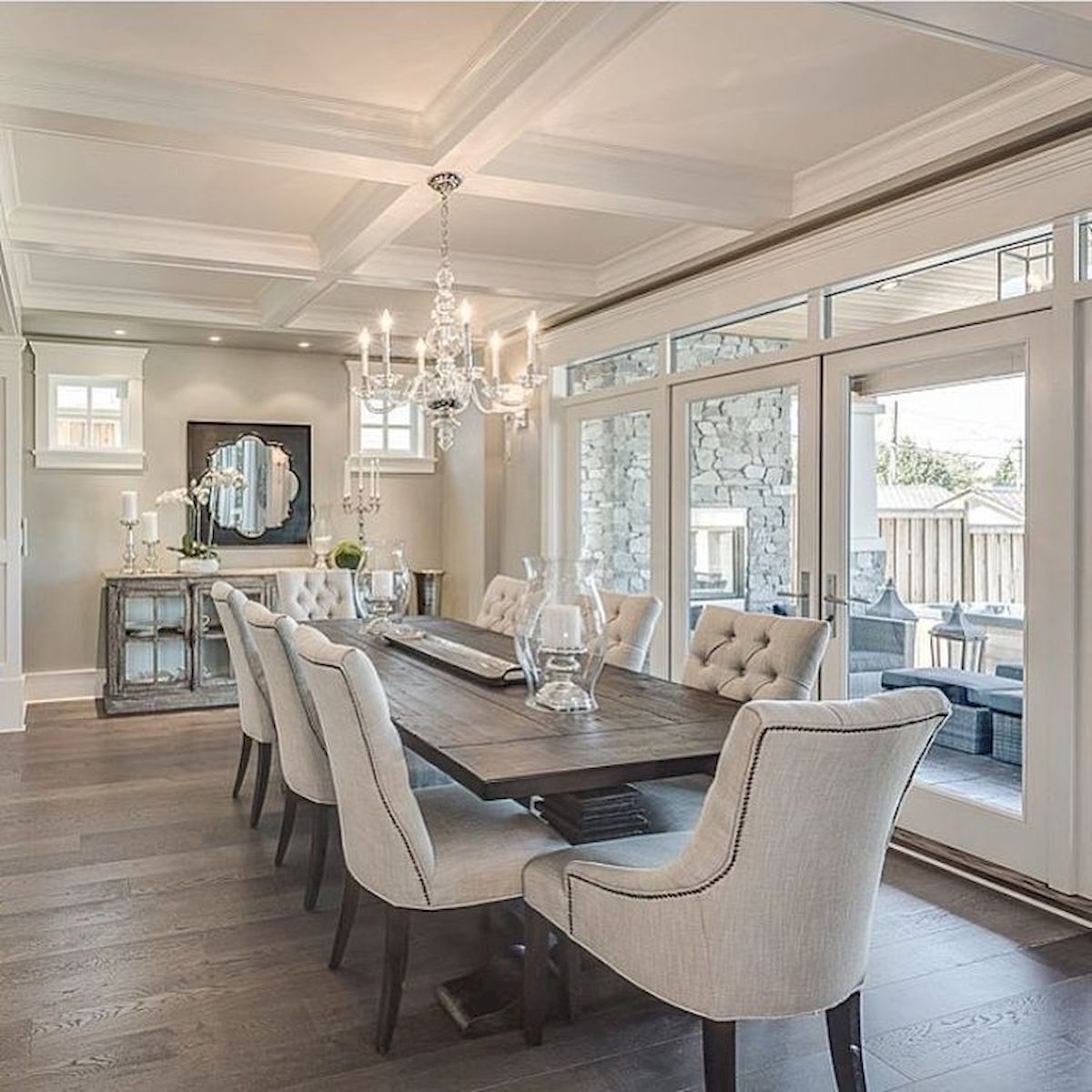
Source: pinimg.com
Choosing the right materials is crucial for achieving a modern elegant dining room. The materials selected will significantly impact the room’s aesthetic, durability, and overall ambiance. Careful consideration of textures, patterns, and finishes is key to creating a sophisticated and inviting space.
Modern elegant dining rooms often blend sleek, contemporary styles with warm, inviting elements. This balance is achieved by thoughtful material selections. The interplay of natural materials with sleek metallic accents creates a dynamic contrast, while textures add visual interest and tactile appeal.
Flooring Materials
Flooring plays a significant role in the overall aesthetic and functionality of a dining room. Durable and stylish options are essential. Hardwood, particularly engineered hardwood, is a popular choice for its warm, natural beauty and enduring quality. Luxury vinyl plank (LVP) offers a cost-effective alternative that mimics the look and feel of hardwood while being more resistant to moisture. Stone tiles, such as porcelain or ceramic, are also excellent choices for their durability and various design options. They can provide a sleek and modern look. Consider the traffic flow and the desired level of warmth and elegance when selecting a flooring material.
Wall and Ceiling Materials
Walls and ceilings in modern elegant dining rooms often take a less prominent role, allowing the furniture and accessories to take center stage. Smooth, neutral-toned paints or wallpapers are frequently employed to create a clean, uncluttered backdrop. For added texture, consider using textured paints or wallpaper. In some cases, exposed brick or shiplap walls can introduce an element of rustic charm that blends seamlessly with a modern design. Ceilings are often painted a neutral color to maintain a sense of spaciousness and openness.
Texture and Pattern
Texture and pattern are essential for adding visual interest and depth to the dining room. Smooth surfaces can create a sense of calm and sophistication, while textured surfaces add visual interest. Subtle patterns, like subtle stripes or subtle geometric designs, can elevate the room without being overpowering. The choice of pattern and texture should be complementary to the overall design and not overwhelm the room’s aesthetic. Natural materials like wood often offer inherent textural appeal.
Material Finishes
Different finishes offer varying degrees of shine and visual impact. Matte finishes are popular for their understated elegance, creating a calm and serene atmosphere. Glossy finishes, on the other hand, can add a touch of glamour and visual vibrancy, but need careful consideration to avoid overwhelming the room. Textured finishes can introduce depth and tactile interest, adding visual interest and warmth. The choice of finish should align with the desired aesthetic and the overall design concept.
Natural Elements
Incorporating natural elements like wood and stone adds warmth and a connection to nature. Wood, in various forms such as hardwood floors or wooden accents, provides a grounding presence and a touch of natural beauty. Stone, whether in tiles or countertops, offers a luxurious and enduring appeal, contributing to the room’s aesthetic. Natural materials can create a sense of harmony and balance.
Metallic Accents
Metallic accents, such as brass, copper, or stainless steel, introduce a touch of sophistication and modern flair. These elements can be incorporated into lighting fixtures, decorative objects, or even the furniture. Metallic accents create a visual focal point, adding a touch of modern elegance.
Material Comparison Table
| Material | Visual Characteristics | Tactile Characteristics |
|---|---|---|
| Hardwood | Warm, natural tones; rich grain patterns | Warm, smooth, and durable |
| Luxury Vinyl Plank (LVP) | Mimics hardwood; wide variety of colors and patterns | Durable, water-resistant, and easy to maintain |
| Stone Tiles | Variety of colors, patterns, and textures; sleek and modern | Durable, cool to the touch |
| Neutral Paint | Clean, calm, and versatile | Smooth, easy to maintain |
| Textured Paint | Depth and visual interest | Slightly rough, tactile appeal |
Styling Ideas and Inspiration
Transforming your dining room into a modern elegant haven involves more than just selecting furniture; it’s about weaving a cohesive narrative through design choices. Inspiration comes from a myriad of sources, ranging from contemporary architectural trends to classic design principles. This section explores various avenues to achieve this aesthetic, from diverse design styles to the strategic use of color and material.
A modern elegant dining room is a statement of refined taste and functionality. It’s about creating a space that is both visually appealing and comfortable, capable of accommodating both intimate gatherings and grand celebrations. Key to this is understanding the interplay of different design elements and their ability to unify the room into a harmonious whole.
Examples of Modern Elegant Dining Room Designs
Different design approaches can embody modern elegance. Consider a sleek, minimalist design featuring clean lines, neutral tones, and a focus on high-quality materials. Alternatively, a more dramatic approach might incorporate bold colors and striking textures. The choice ultimately depends on the homeowner’s personal style and the overall atmosphere they wish to cultivate.
Examples include:
- Contemporary Minimalist: This style emphasizes simplicity and functionality. Furniture pieces often feature clean lines and lack ornamentation. The palette is typically neutral, allowing the architectural details and lighting to take center stage. Natural materials like wood and stone are frequently incorporated, providing a sense of warmth and grounding.
- Industrial Chic: This style blends industrial elements with modern elegance. Exposed brick, metal accents, and concrete floors are common features. Dining tables with metal legs and sleek, minimalist chairs are often selected to complement the industrial aesthetic. Lighting plays a significant role, often featuring pendant lights or track lighting.
- Modern Farmhouse: This style merges the warmth of a farmhouse with the clean lines of modern design. Natural wood tones, rustic textures, and soft lighting create a cozy and inviting ambiance. Dining tables and chairs might have a slightly more traditional feel, yet maintain a sense of understated elegance.
Creating a Modern Elegant Dining Room in Different Sizes and Shapes
The size and shape of a dining room influence the design choices. A smaller room requires careful consideration of furniture placement to avoid overcrowding. Conversely, a larger room offers more flexibility for experimentation with different layouts and configurations.
- Small Spaces: Opt for sleek, space-saving furniture. Mirrors can visually expand the room, while strategically placed lighting can create a sense of openness. Choose a compact dining table and chairs, and consider using multi-functional pieces.
- Large Spaces: Large spaces provide an opportunity to incorporate a variety of design elements and create zones within the dining room. A large dining table can be the focal point, with seating arranged around it in a way that encourages interaction. Large windows or architectural features can be highlighted with carefully selected furniture and lighting.
- Irregular Shapes: Embrace the unique characteristics of the space by creatively arranging furniture to complement the room’s contours. Curved walls can be accented with similarly curved furniture or lighting fixtures. This approach can create a sense of flow and visual interest.
Incorporating Modern Elegance into Different Architectural Styles
Modern elegance can harmonize with various architectural styles.
- Modern Architecture: The clean lines and minimalist aesthetic of modern architecture readily integrate with modern elegance. Minimalist furniture, neutral palettes, and a focus on natural light are key to this approach.
- Contemporary Architecture: Contemporary architecture often features bold lines and geometric shapes. Modern elegance can be achieved through a balance of bold and subtle elements, using contrasting materials and textures.
- Traditional Architecture: Modern elegance can be seamlessly integrated into traditional architecture through the selection of contemporary furniture and accessories. Neutral tones and high-quality materials can help to balance traditional features with modern aesthetics.
Color Theory in Modern Elegant Dining Rooms
Color theory plays a crucial role in setting the mood and creating visual interest in a modern elegant dining room.
- Neutral Palettes: Neutral tones like white, beige, gray, and cream create a sense of calm and sophistication. These colors allow the furniture and accessories to stand out.
- Accent Colors: Introduce pops of color through accessories like rugs, artwork, or decorative items. These accent colors can complement the overall palette and add visual interest.
- Color Coordination: Ensure that the colors used throughout the room complement each other and create a cohesive look. Consider the relationship between colors in the color wheel to achieve harmonious combinations.
Creating a Cohesive and Unified Look
A cohesive look in a modern elegant dining room is achieved through careful consideration of every element.
- Consistent Style: Maintain a consistent design style throughout the room, ensuring that all elements—furniture, lighting, accessories—harmonize with each other.
- Balanced Proportions: Ensure that furniture and accessories are proportionally balanced within the space, creating a sense of equilibrium.
- Focal Point: A focal point, like a stunning chandelier or a large piece of artwork, can unify the space and draw the eye to the key elements of the design.
Modern Elegant Dining Rooms with Different Themes and Features
- Rustic Modern Elegance: Incorporates natural elements like wood and stone with sleek, modern furniture. Warm lighting and natural textures create a cozy and inviting ambiance.
- Coastal Modern Elegance: Utilizes light and airy tones with natural materials like rattan and wicker. Incorporates nautical-inspired accents to add a touch of coastal charm.
- Urban Modern Elegance: Features sleek lines, metallic accents, and industrial-inspired elements. Modern art and sophisticated lighting are key elements.
Ending Remarks
In conclusion, designing a modern elegant dining room involves a blend of style, functionality, and thoughtful consideration. From choosing the right furniture and lighting to maximizing space and incorporating natural elements, this guide provides a comprehensive overview. Hopefully, this has given you a solid foundation to create your dream dining space. Now go forth and create your modern elegant dining room masterpiece!
Quick FAQs
What are some common material choices for modern elegant dining room flooring?
Hardwood, polished concrete, or large format porcelain tiles are popular choices, often in neutral tones.
How can I incorporate natural elements into a modern elegant dining room?
Use natural wood accents, incorporate plants, and choose a color palette that reflects nature, like warm neutrals or earthy tones.
What are some tips for creating a modern elegant dining room in a small space?
Mirrors to reflect light, multi-functional furniture, and open layouts can maximize a small space. Choose light-colored walls and furniture to visually expand the room.
How can I achieve a cohesive look in a modern elegant dining room?
Maintain a consistent color palette, choose complementary furniture styles, and use similar textures and materials throughout the room.
What are some popular dining table shapes for modern elegant spaces?
Rectangular, square, or even round tables are common. The shape should be chosen to best fit the room’s dimensions and the desired seating arrangement.
- Obscure Glass A Detailed Look - June 2, 2025
- Home Automation System Your Smart Home Guide - May 6, 2025
- Urban Modern Home Design & Lifestyle - May 6, 2025

